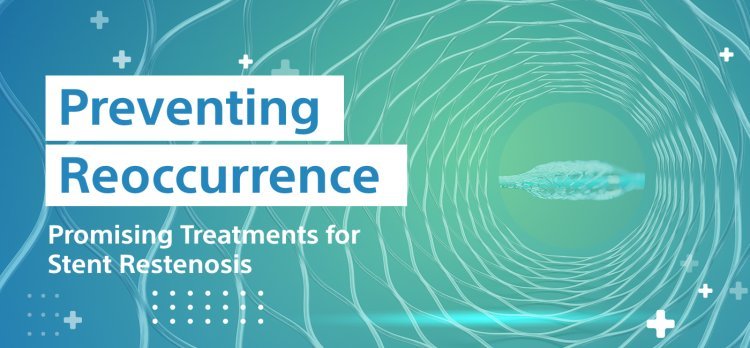Preventing Reoccurrence: Promising Treatments for Stent Restenosis
Although the management of stent restenosis poses a continuing dilemma in the interventional cardiology domain, an in-depth understanding of the mechanisms involved, coupled with improvements in therapeutic regimens, will provide a means of overcoming the problems of restenosis. Through a comprehensive strategy integrating pharmacological optimization, interventional techniques, and emerging therapies, medical experts have shown chances for better outcomes with the low recurrence of stent restenosis.

Stent restenosis, an issue widespread in coronary intervention, implies severe clinical consequences. Although progress has been made in stent development, restenosis is still relevant, as it affects a significant percentage of patients post-procedure. This event is characterized by the dilatation of the artery caused by excess tissue growth around the stent, which results in the recurrence of the symptoms and may even require reintervention.
Mechanisms and Manifestations
The pathogenesis of stent restenosis is complex and multifactorial. The vascular smooth muscle cells multiply after stent implantation, causing neointimal hyperplasia. Excessive tissues narrow the arterial lumen, ultimately hindering the blood flow. The disease presentation may range from asymptomatic ones, which are revealed incidentally, to symptomatic presentation, including angina pectoris or myocardial infarction.
Evaluation and Diagnosis
Precise diagnosis of stent restenosis is crucial for immediate intervention. Diagnostic modalities cover invasive techniques, including coronary angiography and intravascular imaging, in addition to non-invasive approaches like stress testing and cardiac MRI. These evaluations help establish the degree and extent of neointimal overgrowth, guiding future therapeutic strategies.
Treatment Modalities: A Multifaceted Approach
As far as stent restenosis is concerned, an integrative approach, combining pharmacological, interventional, and novel treatment options, is needed.
Pharmacological Interventions
Drug therapy is paramount in preventing stent restenosis. Antiplatelet drugs that include aspirin & P2Y12 inhibitors, prevent post-stenting thrombotic events, thus minimizing restenosis. Furthermore, drug-eluting stents (DES) covered with antiproliferative agents, including sirolimus or paclitaxel, exhibit superior efficacy in preventing neointimal hyperplasia and so reduce the restenosis rates in comparison with bare-metal stents (BMS).
Interventional Strategies
In the case of symptomatic restenosis, interventional procedures provide definitive management. Percutaneous coronary intervention (PCI), the most widely used method in restenotic lesions, can restore arterial patency with balloon angioplasty and, if necessary, stent implantation.
Intravascular imaging techniques, namely intravascular ultrasound (IVUS) or optical coherence tomography (OCT), help in accurate lesion assessment, consequently improving procedural outcomes.
Emerging Therapies
Biomedical engineering innovations for curing stent restenosis have brought in new strategies. The bioresorbable scaffolds ({\bf BRS}) are a paradigm shift in the stenting technology, and by degrading, they deliver vascular support and reduce the risk of neointima hyperplasia. Further, the drug-coated balloons (DCB) provide antiproliferative agents directly to the lesion site; thus, a targeted therapy with less systemic exposure to the drug is obtained.
Novel Therapeutic Frontiers
Novel therapeutic options can potentially redefine the stent restenosis management paradigm. Treatments that act upon stabilizing signals implicated in neointimal hyperplasia have potential as precision medicine strategies in restenosis prevention. The strategies focusing on factors including platelet-derived growth factor (PDGF) and transforming growth factor-beta (TGF-β) signaling pathways have demonstrated efficacy in preclinical studies, hence needing clinical validation.
Personalized Medicine Approaches
The arrival of personalized medicine ushers in a new paradigm in restenosis where genetic, proteomic, and imaging data is utilized to personalize the treatment to the patient’s profile. Genetic profiling can reveal genetic variants associated with increased susceptibility to restenosis, bringing about risk stratification and individualized treatment regimens. Analogously, proteomic markers may provide a window into the pathophysiological processes that lead to restenosis, enabling targeted therapeutic strategies.
Enhanced Surveillance Strategies
Close contact between the surveillance strategies and early restenosis detection and intervention are essential. New imaging modalities like fractional flow reserve (FFR) and coronary computed tomography angiography (CCTA) offer integrated anatomical and functional evaluation, allowing accurate lesion identification and optimal treatment planning. Incorporating AI algorithms in imaging interpretation adds diagnostic accuracy and efficiently makes it possible for clinicians to arrive at a decision fast.
Conclusion
Although the management of stent restenosis poses a continuing dilemma in the interventional cardiology domain, an in-depth understanding of the mechanisms involved, coupled with improvements in therapeutic regimens, will provide a means of overcoming the problems of restenosis. Through a comprehensive strategy integrating pharmacological optimization, interventional techniques, and emerging therapies, medical experts have shown chances for better outcomes with the low recurrence of stent restenosis.
In pursuit of optimum patient care, embracing constant research and innovation is necessary to sharpen existing therapies and discover other techniques that will defeat stent restenosis. With joint endeavors from clinicians, researchers, and medical device providers, the terrain of coronary intervention is being re-shaped, bringing promise for better outcomes and quality of life for patients suffering from stent restenosis.
What's Your Reaction?











![Wireless Connectivity Software Market Size, Share | Statistics [2032]](https://handyclassified.com/uploads/images/202404/image_100x75_661f3be896033.jpg)




